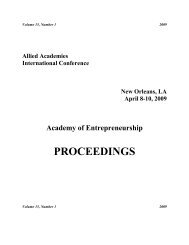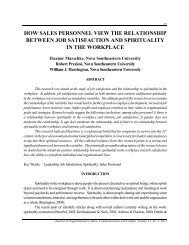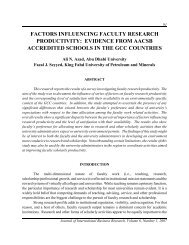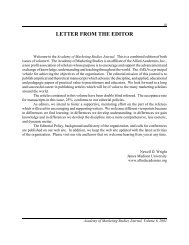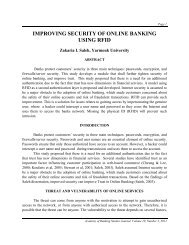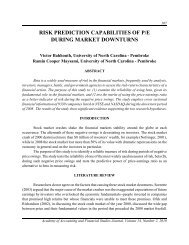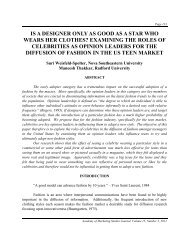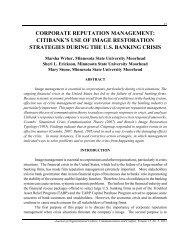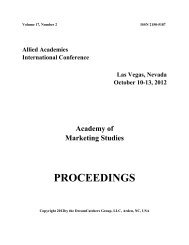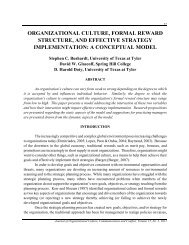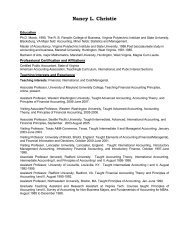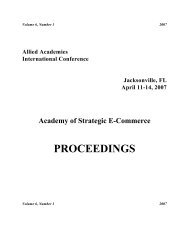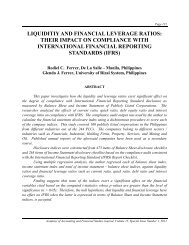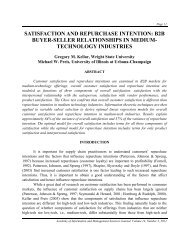CREATING AN EFFECTIVE ONLINE LEARNING ENVIRONMENT: A ...
CREATING AN EFFECTIVE ONLINE LEARNING ENVIRONMENT: A ...
CREATING AN EFFECTIVE ONLINE LEARNING ENVIRONMENT: A ...
Create successful ePaper yourself
Turn your PDF publications into a flip-book with our unique Google optimized e-Paper software.
<strong>CREATING</strong> <strong>AN</strong> <strong>EFFECTIVE</strong> <strong>ONLINE</strong><br />
<strong>LEARNING</strong> <strong>ENVIRONMENT</strong>:<br />
A SHIFT IN THE PEDAGOGICAL PARADIGM<br />
Sanjay Gupta, Valdosta State University<br />
Jacqueline K. Eastman, Valdosta State University<br />
Cathy Owens Swift, Georgia Southern University<br />
ABSTRACT<br />
The emergence of the Internet and the World Wide Web has significantly changed every<br />
aspect of business. Education, too, has changed considerably as evidenced by the exponential<br />
increase in online courses. Online courses offer numerous advantages over traditional courses to<br />
administrators, instructors, and students. However, while the use of online courses is increasing,<br />
it remains unclear whether the pedagogical and learning approaches, that are required to make<br />
these courses effective, are keeping pace with the ability to deliver such courses.<br />
The primary objective of this paper is to describe the growth and development of distance<br />
education, discuss the three dimensions of teaching online courses, examine some of the issues and<br />
concerns for faculty teaching online courses, and provide some implications for faculty either<br />
teaching or considering teaching online courses.<br />
INTRODUCTION<br />
Distance education has experienced exponential growth in the past decades. An increasing<br />
number of universities, both large and small, currently offer entire degree programs in a distance<br />
learning environment. More than half of the 2,215 four-year colleges and universities in the U.S.<br />
offer distance-learning courses (Gubernick and Ebeling 1997; Vasarhelyi and Graham 1997). In<br />
1998 there were 710,000 students taking distance education classes and that number is expected to<br />
climb to 2.2 million in 2002 (Koury 2000). While total college enrollments are increasing at a rate<br />
of about 2% per year, distance education enrollments are increasing at a rate of approximately 30%<br />
per year (Bertagnoli 2001).<br />
The most recent development in distance education is the use of online courses delivered<br />
through the Internet. Three major factors have spurred the growth of online courses. First, the cost<br />
of education has soared, and universities are seeking more economical methods of course delivery.<br />
Second, compression technologies, increased computing power and speed, reduced costs, and an<br />
increased comfort level with technology have increased the ease of learning online. Third, the<br />
Academy of Educational Leadership Journal, Volume 9, Number 3, 2005<br />
79
The body of this manuscript is not reproduced in this posting. The full text of the manuscript is<br />
available through most university libraries. Should you have difficulty in finding the full text,<br />
you may acquire it from the original journal. Visit http://www.alliedacademies.org to find a link<br />
to the original journal source.
Recent research has documented an increase in student participation for online courses<br />
versus traditional face-to-face courses (Hiltz and Wellman 1997). Increased active participation by<br />
online students, involving discussing and doing, rather than passive participation, in the form of<br />
receiving lectures in a traditional course, is associated with increased learning. Recent research has<br />
also found that online courses are as effective as traditional courses (Borthick and Jones 2000;<br />
Schulman and Sims 1999) with respect to achieving learning objectives.<br />
Contrary to Drucker’s opinion, online learning will not replace the traditional classroom.<br />
We don’t believe that online learning will replace the traditional classroom. Higher education has<br />
diverse learning goals that require a multifaceted array of educational strategies. Since the learning<br />
needs of students are also diverse, providing options for all of those students will be essential. The<br />
market for online education will continue to expand into the next century and business faculty who<br />
want to stay in the forefront of education would be wise to embrace the opportunities offered by this<br />
exciting new teaching and learning paradigm.<br />
REFERENCES<br />
Banas, E. J. & W. F. Emory (1998) "History and Issues of Distance Learning," Public Administration Quarterly, 22 (3),<br />
365-383.<br />
Bates, A. W. (1995) Technology, Open Learning and Distance Education, London: Routledge Publishing.<br />
Bertagnoli, L. (2001) "Education Reservation," Marketing News, 35(4), 4.<br />
Blumeststyk, G. (1996) "Faculty Group Calls for Caution and Curbs on Distance Education," Chronicle of Higher<br />
Education, 42, A20.<br />
Borthick, A.F. (2000) "Analysis of Design from a Community of Practice Dialog: Negotiating the Meaning of Auditing<br />
Information System Development," Journal of Information Systems, 14<br />
Borthick, A.F. & Jones, D.R. (2000) The Motivation for Collaborative Discovery Learning Online and its Application<br />
in an Information Systems Assurance Course," Issues In Accounting Education, 15(2), 181-210.<br />
Davie, L.E. & R.Wells, (1991) "Empowering the Learner Through Computer Mediated Communication," American<br />
Journal of Distance Education, 5(1), 15-23.<br />
Dolence, M.G. & D.M. Norris (1995) Transforming Higher Education: A Vision for Learning in the 21st Century, Ann<br />
Arbor, MI: Society for College and University Planning.<br />
Green, K. (1996) Nontraditional education: Alternative ways to earn your credentials. Occupational Outlook Quarterly,<br />
40(2): 22-35.<br />
Gubernick, L. & A. Ebeling (1997) "I Got My Degree Through E-mail," Forbes, 159 (12), 84-92.<br />
Academy of Educational Leadership Journal, Volume 9, Number 3, 2005<br />
87
88<br />
Harasim, L.M., S.R.Hiltz, L.Teles & M.Turoff (1995) Learning Networks: A Field Guide to Teaching and Learning<br />
Online, Cambridge, MA: MIT Press.<br />
Hiltz, S.R. & B. Wellman (1997) "Asynchronous Learning Networks as a Virtual Virtual Classroom," Communications<br />
of the ACM, 40(9), 44-49.<br />
Hubbard, S. (1997) Teaching courses through distance education, Cornell Hotel & Restaurant Administration Quarterly,<br />
38(4): 82-86.<br />
Koury, C. (2000) "Busy People go to College Online," Telegram & Gazette, February 24, F38.<br />
Leidner, D.E. & M. Fuller (1997) "Improving Student Learning of Conceptual Information: GSS Supported<br />
Collaborative Learning vs. Individual Constructive Learning," Decision Support Systems 20, 149-163.<br />
Macdonald, S. (1995) "Learning to Change: An Information Perspective on Learning in the Organization," Organization<br />
Science, 6(5): 557-568.<br />
McCormack, C. & D. Jones (1998) Building a Web-Based Education System, New York: John Wiley & Sons, Inc.<br />
Noble, D. F. (1998) "Digital Diploma Mills, Part II: The Coming Battle Over Online Instruction," Sociological<br />
Perspectives, 41 (4), 815-825.<br />
Raelin, J.A. (1997) "A Model of Work-Based Learning," Organization Science, 8(6), 563-578.<br />
Schulman, A.H. & R.L. Sims (1999) "Learning in an Online Format Versus an In-Class Format: An Experimental<br />
Study," T.H.E. Journal, 26(11), 54-56.<br />
Schwartz, H. (1995) "Computers and Urban Commuters in an Introductory Literature Class," in Computer-mediated<br />
Communication and the Online Classroom, Volume 2: Higher Education, edited by M. Collins and Z.L. Berge,<br />
Cresskill, NJ: Hampton Press, 79-92.<br />
Vasarhelyi, M.A. & L. Graham (1997) Cybersmart: Education and the Internet. Management Accounting<br />
(imastudents.org Supplement), 32-36.<br />
Academy of Educational Leadership Journal, Volume 9, Number 3, 2005



